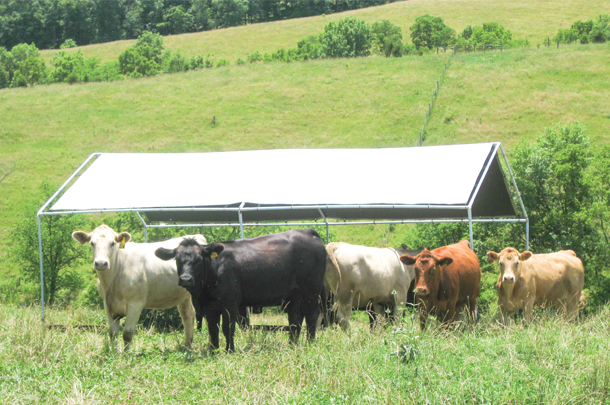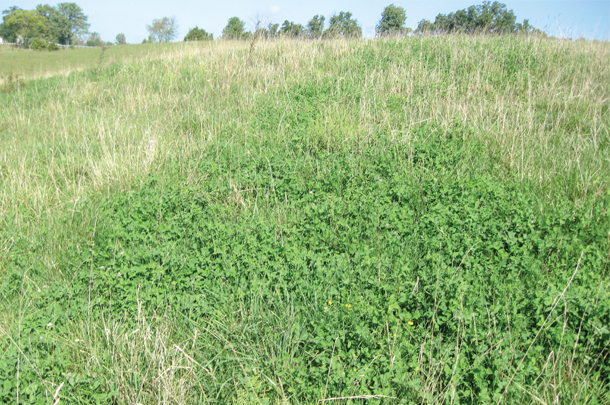Cattle often receive drugs at different stages of production. Vaccines and anthelmintics are given to young calves, while steroid implants and antibiotics are typically used in backgrounding and finishing.
These drugs have revolutionized modern production systems, but they have been criticized and increasingly regulated. The use of antibiotics for growth promotion has been especially criticized because of contributions to antibiotic resistance in bacteria, so we have to find other ways.
People have always used food to overcome illness and improve health. Human nutritionists have recently started calling foods with medicinal value functional foods. We borrowed that idea to look for a functional feed, a plant, or plant-based product, which could be used to achieve the same benefit as antibiotic growth promoters.
The candidate functional feed is red clover. Clovers are rich in protein and can be used to meet the protein requirements of ruminants. Clovers, like many members of the legume family, also make a class of chemical compounds called isoflavones.

Most of the older research on isoflavones has been about the negative effects on reproduction in specific circumstances. For example, a large proportion of red clover in the diet has interfered with the estrus cycle in sheep and reduced lambing rates in some cases.
However, some isoflavones have beneficial health effects for people. They have been shown to reduce the symptoms of menopause and reduce high blood pressure. Because red clover is so rich in biologically active compounds, we chose to look there first.
How do antimicrobial growth promoters work?
To evaluate clover compounds as antimicrobials, we first need to understand how antibiotic growth promoters work. Most antimicrobial growth promoters that we use are antibiotics, that is, they are made by micro-organisms to kill other micro-organisms.
The rumen is densely populated with many types of bacteria and other micro-organisms. Some bacteria, like those that break down fiber, are very important. Cattle cannot get energy from grass or hay without these bacteria.
Others carry out wasteful processes, such as methane production and protein degradation. Think of these wasteful bacteria as weeds; they decrease the productivity of a rumen in the way that weeds can decrease the productivity of a pasture.
Antimicrobial growth promoters can increase the productivity of a rumen by the same ecological principle that herbicides can increase the productivity of a pasture, by selectively controlling the growth of certain species. Antimicrobial growth promoters, like herbicides, are tools that allow you to direct nutritional resources the way you want them to go.
Let’s focus on protein. Plant protein passes into the rumen. It is broken down into amino acids by one group of micro-organisms; then another group converts the amino acids into ammonia.
Beneficial bacteria recapture some of the ammonia, but much of it is transported into the blood and is lost in the urine. When ammonia production decreases, more protein-nitrogen makes it into animal tissue.
Protein and amino acids that survive the rumen are called bypass protein and can be absorbed by the animal in the lower digestive tract. The group of rumen bacteria that converts most of the feed amino acids into ammonia is called the hyper ammonia-producing bacteria (HAB). Antimicrobial growth promoters kill HAB, which increases bypass protein, feed efficiency and weight gain.
The clover antimicrobial
We began by extracting a mixture of compounds from red clover (cultivar Kenland). The extract was tested against rumen HAB in our USDA-ARS laboratory at the University of Kentucky. It was determined that the extract could prevent the growth and ammonia production by the HAB.
This result indicated red clover contained at least one compound that had the desired antimicrobial property. The natural products in the extract were chemically separated and screened for activity using the pure HAB culture. The compound that prevented growth of the HAB was identified as an isoflavone called biochanin A.

Once it was determined that the red clover isoflavone, biochanin A, could reduce ammonia production from rumen bacteria by killing the same bacteria as antibiotic growth promoters, then the next step was to test its ability to promote growth in cattle. We carried out two grazing trials in the spring and fall of 2015.
In each trial, 48 Angus-cross steers were put on pasture (novel endophyte fescue with no legume) in one of three groups: pasture only, pasture plus dry distillers grains or pasture plus dry distillers grains with added biochanin A.
The biochanin A was given at 7 g per head a day, which is equivalent to the amount of biochanin A in a diet of approximately one-third red clover. The average daily gains were calculated at the end of the 63- and 61-day trials. The trials have not been reported in a scientific journal, but the results are promising in showing improved average daily weight gain with the addition of biochanin A.
Conclusions
We believe that the isoflavones, including biochanin A, and other bioactive compounds may explain many of the benefits seen in animals grazing clover. It is well known that Rhizobia bacteria that colonize in the roots of clovers fix nitrogen, and the clovers convert the nitrogen to valuable protein for grazing ruminants.
Now there are reasons to believe that the isoflavones in clover also improve utilization of the protein and promote weight gain by influencing rumen bacteria in a manner similar to antibiotic growth promoters.
Isoflavones are estrogenic, which means they have to be used carefully. For example, different feeding levels might be recommended for backgrounding and finishing beef versus pre-weaning.
There are also special considerations for sheep, which are believed to be particularly sensitive to reproductive effects of plant estrogens.
Clearly, more research is needed on the biologically active chemicals made by forage legumes as well as how to best utilize them as functional feed. However, the results with red clover isoflavones indicate that a new tool for cattlemen might come from forage we had all along.
PHOTO 1: Heifers on a clover-grass mixture.
PHOTO 2: A strong stand of red clover in mixture with tall fescue, orchardgrass and Kentucky bluegrass. Photos provided by the Kentucky Beef Network.







